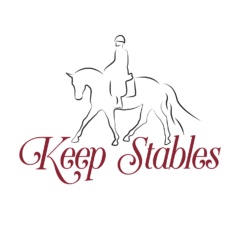Article from HorseMagazine.com , it is a repost from their own article from 1986. Still just as accurate today as it was then.
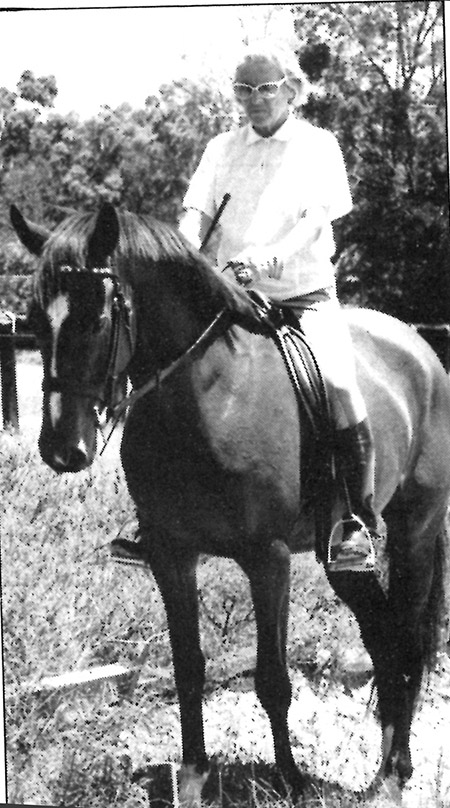
Chris Hector takes a lesson with Tina Wommelsdorf
We published this story back in 1986, it is a sobering thought that 30 years down the track, the same fundamental problem shows itself over and over again in the dressage arena…
You’ve probably witnessed the conversation a hundred times.
The horse has disgraced himself.
The offence may vary. Perhaps he cantered too fast, or too slow, or refused to canter at all – the post mortem often has a depressing sameness: Perhaps he is sore, maybe you should try BTZ? Do you think his teeth might need attention? Have you tried him in a mechanical hackamore? I had a horse that wouldn’t canter and my chiropractor had him right in ten minutes! It’s his breeding, those XYZs are always a problem…
And on and on goes the list, and all the time the cause of the problem is sitting right there (literally) in front of them. The rider simply cannot ride well enough to expect the horse to perform!
The horse has not yet been born that will continue to function with the rider bouncing, gripping in the saddle and pulling on his mouth. Sure, you can bang a double bridle on his head and hide the problem for a while. Or get one of the fix-them-quick experts to do an instant ‘re-education’ job on him – to bash him into submission for a while, but eventually the truth will out.
Eventually he will run through the most severe bit. Eventually no amount of bashing will cower him into submission. And then we are back with that original, inescapable conclusion.
The problem lies not with the horse but with the rider… and it is a case of rider heal thyself.
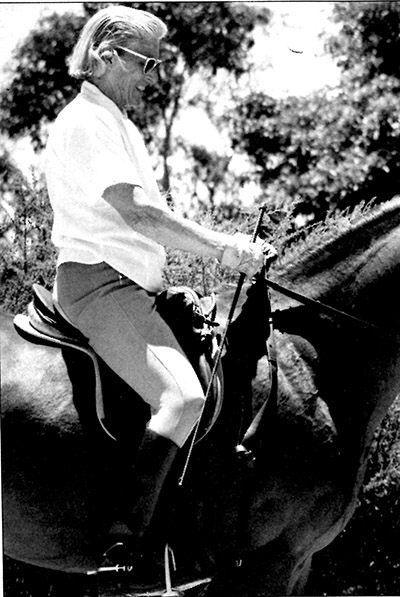
Of course there will be some who take the other option. Sell the horse as a hopeless case (he probably is by now), and start in on wrecking another. That this sort of process is repeated time and time again all over the land, is a everlasting condemnation of those instructors who are more interested in telling their clients what they wish to hear than offering them a simple and surefire solution:
‘We will just have to get your position right. On the lunge, with no stirrups or reins, until you are secure in your seat.’
It is not such a pleasant experience, but a month or so on the lunge can be the beginning to a lifetime’s enjoyable riding, for both horse and rider, and surely is not such a price to pay?
Of course there are some instructors who will not absolve the rider and blame the horse. Instructors like Tina Wommelsdorf. Tina has travelled the length and breadth of Australia spreading the message that riding starts with the rider. Go to one of her schools – as I was fortunate enough to do recently – and the message is hammered home.
The horse’s problems are problems caused by the rider. Until the rider learns self discipline, no success can be achieved.
It is not a fashionable message, not a welcome one to many, but Tina has seen fashions come and go. She has seen the gimmick trainers with their instant solutions come, and just as quickly go… and nothing in their routine of miracle cures has caused her to deviate from the principles she learnt in ten years at the German Riding School. Principles that were re-inforced and hammered home by the late Franz Mairinger, The principles by which Tina trains her own horses, and. the same principles that produce the greats of the dressage world, like Dr Neckerman, like the present day superstar, Dr Klimke.
“The problem lies with the rider’s body,” says Tina, “because the body reacts to what the horse is doing instinctively, and not at the rider’s command. The riders are not aware of what is happening, so they get stuck with their hands, which is the worst thing. Or they don’t push – which is also bad. In other words, their body is just reacting to the horse instead of being told what to do by the rider’s mind, so that they can train the horse.”
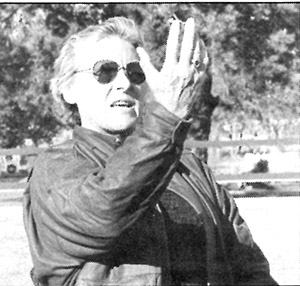
“Even riders who can sit quite well, don’t seem to be in control of their hands. The hands can wreck everything. If you surrender both reins, if you have a loop in the reins to teach yourself not to hang on – then you can’t hang on, and you have to ride forward instead of sideways. It doesn’t matter how well they can sit, if their hands are not under control and they jam, then they cause a jam in the horse. You can’t isolate the jam in your own hand, if you have a jam in your hand, you have a jam in the horse.”
“Unless the rider is completely in charge of the hands and is able to ride the horse into a forward reaching hand, he will create a jam in the horse, and then the horse cannot perform to the best of his ability – in fact, usually the horse will not be able to bend to one side.”
“The rider must concentrate on position. Your position is everything. If your position is wrong, then the horse cannot go. It is technically not possible because you are causing that famous jam.”
“You will even see it in the higher tests. Riders are stuck on one rein, and it is usually the side that the horse is naturally bent to. The horse does a lovely half pass to one side – and next to nothing to the other, because the rider is holding the horse on that rein. The horse can’t bend the other way.”
“The best way to overcome this problem is to surrender the contact on both reins, so that the rider’s body cannot involuntarily take up one rein and hold it. While the rider’s hands maintain contact, the body is just so quick in instinctively holding one rein that the rider is just not aware of it. Particularly since the rider has probably been doing it for a long long time. If you surrender both reins, if you have a loop in the reins to teach yourself not to hang on – then you can’t hang on and you have to ride forward instead of sideways.”
“The rider is inclined to do all the corrections with the hands, when the riders should be doing the corrections with the seat and the legs.”
Right through the school, Tina emphasised the importance of correctly riding forward and into a corner – rather than trying to pull and steer the horse onto the line.
One youngster was so spooky in the indoor school, that his rider had come equipped with trotting blinkers… and still he attempted to shy out of the corner!
“No, don’t pull, just ride him straight into the corner straight, forward,” came the command.
“Impossible,” came the reply.
“I will show you.”
Tina positions herself a few yards in from the corner. The rider rides straight ahead, the horse comes to a halt, deep in the corner, his chin practically resting on the wall of the school.
“See, it works.”
“But you were standing there … ”
“OK, I will stand back, now do it again.”
Tina is well and truly clear of the corner and the horse still goes deep and comes to the halt. And to drive the lesson home, Tina gets on board, and rides the horse dead straight into the corner with a half-moon loop in the reins! The rider is impressed.
“You can demonstrate to the rider when you make them ride straight into the corner and stand next to the wall, they CAN get there if they ride forward. They will wobble all over the place if they try to ride sideways! Once the rider goes straight into the corner, they get the feeling of riding forward, instead of trying to hold the horses out. Then they can transfer this same feeling to riding on a curved line, also forward, then they get the idea of forward riding.”
“If you can make the horse go forward, then the hands will not be tempted to act incorrectly. I want the rider’s hands forward reaching so you are bringing the horse to the bit – not the bit to the horse. If you start with the head, you are not riding the horse, you are jamming it in. You must bring the horse to the bit, so he is engaged and carries himself.”
“The head position occurs all by itself, it falls into your hands. The horse’s nose will not poke out if you can push him sufficiently to take more weight on the hindquarters. He will automatically round himself if you have an amiable contact with him.”
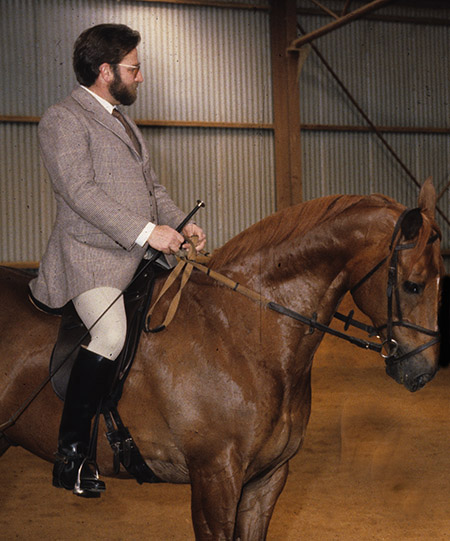
Christopher and Cedar contemplate the mystery of the forward reaching hand…
Perhaps I am a bit thick, but for a long time I had problems understanding Tina’s ‘forward reaching’ hand. Somehow I had it in my head that the hand had to actually move forward at the moment of the push. What Tina was talking about is far simpler. The forward reaching hand simply means that the hands are positioned well in front of the body, making a straight line from the elbow to the bit.
Tina would demonstrate over and over again that if you let the reins go long and the hands come back to the body, then that forward going impulse is lost. The immediate worry was that by shortening the reins you would shorten the neck, but it soon became apparent that with the hands in the correct position, Cedar could still travel in a long outline and on a relatively short rein.
But the horses were not expected to rush around the arena with absolutely no contact. Once the rider’s hands had learnt the lesson of the no contact position, they were expected to half halt/check (remember most riders back then had no idea what half halt meant) over and over again…
“You can’t keep on pushing without checking. Otherwise the horse gets faster, faster, faster. You have to have half halts to maintain a tempo that is yours – otherwise you can’t push. And unless you can push, you cannot train. You have to keep on checking the tempo of the horse so that you can push him, and when you push you can engage the hind legs correctly, and then his position will follow. He is light in front and he will round himself.”
“Very often the half halt is completely misunderstood by the riders. Or mis-executed! Instead of checking and easing off, they are checking and getting stuck, and it becomes a halt. If you read Reiner Klimke’s writings you will find that he says it is the most important thing in your riding – and that if you get stuck with your hands, you are not riding the horse anymore, you are holding it.”
“The rider should say to himself: ‘I am taking my hands back only reluctantly, to slow the horse down. I will immediately allow them to go forward again, so that I can ride into a forward reaching hand’. The rider must control himself before he can control the horse … and must maintain that control.”
“That is the most important step in your riding is that you can control yourself, and that you know at all times what your hands, seat and legs are doing. You are aware of yourself and your actions.”
“If the rider cannot control his body, then he must go back to the exercises to promote an independent seat. Once the seat is independent, then the arms and legs are independent. Until they have that seat they must go back onto the lunge. No reins, no stirrups· until they learn to sit because they are balanced and not hanging on. If they are not balanced they grab with the legs, and they push the horse inadvertently, and then they grab hold of the rein to slow it down. It is a vicious circle. Or they hang onto the reins for security and that is backwards riding. They are holding the horse instead of riding it.”
“Forward is the most important ingredient in all your riding. If you listen to the Old Masters, they always say ‘Forward is everything’. Ride your horse forward and straighten it. That is always neglected, no-one wants to listen to it, they all want to hear about indirect, opposing reins, and God knows what complicated expressions… when forward is everything. If they follow that forward principle they could ride!”
“It is really sjmple. All collection should be forward, everything is forward. The minute you get a problem, forget what you are doing, just ride forward with both legs, until you have the hindlegs correctly engaged. Then try the exercise again.”
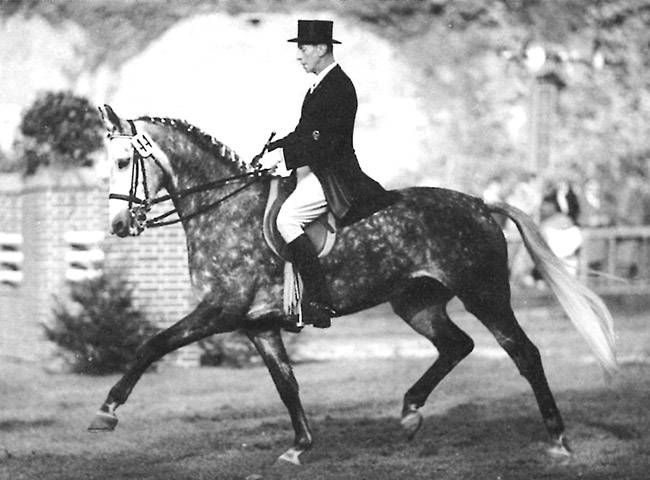
“The great riders are forward riders. Look at Dr Neckermann, he is absolutely the embodiment of forward riding. I have watched him time and time again, and he does all his corrections forward. When his horse won’t stand square and well at the end of the lesson – he rides forward out of that halt time and time again. He never corrects a horse standing still, he rides forward and out to correct. There is no backwards correction, it is all forward.”
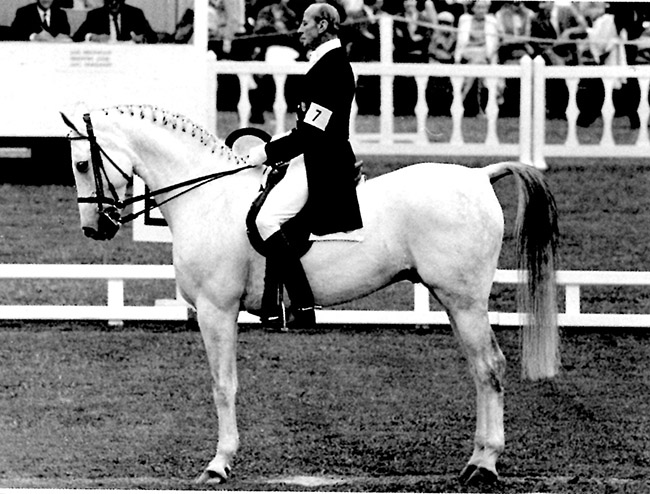
“All movements are forward movements. The flying change is a forward movement, and if you don’t ride them forward, the horse will swing the quarters and you don’t get a straight . line. People seem to think that they want to change from the left to the right. Really the horse must just canter on, either on the left leg or the right leg – forward, not side to side.”
“People don’t seem to want to admit that it is so simple. Perhaps because carrying it out and learning it is not so simple for the rider. The body is basically frightened, self preservation plays its part. When someone gets on a big seventeen hand horse, the legs want to grab so you don’t fall off, the hands want to hang onto the reins so he doesn’t get too fast… To set yourself completely free and say ‘Yes, you may go, I want you to go forward, I will make you go’ takes a lot of self discipline. But that is the only way. When you ride a horse forward, he doesn’t want to run. he horse only runs when he is on the forehand.”
“It all starts with self discipline. With the rider! You ride as you live.”
For the original article, click the link below:
https://www.horsemagazine.com/thm/2017/04/chris-hector-takes-a-lesson-with-tina-wommelsdorf/
